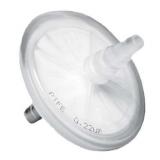Understanding Filter Service Life and Its Implication on Size Selection

A common question users of disk, syringe, and capsule filters ask is: How long will my filter last? Or, put another way: How much fluid can I expect to pass through my filter before it clogs? The answer to this question will help users select appropriately sized filters.
This apparently simple question has a complex answer though as many factors influence filter service life. Service life can be defined as the total volume of fluid that passes through a normal flow filter until it becomes clogged, otherwise referred to as “total throughput.” It is nearly impossible to predict the total throughput of a filter, because factors such as the type of solution being filtered, and the physiochemical characteristics of the solution and the filter may affect filter service life.
Most laboratory filtration applications involve limited volumes of fluid filtered on a batch basis. For these applications, the appropriate filters are not operated to the point of clogging. With reasonable expertise, technical assistance, or even educated guesses, users can confidently select appropriately sized filters and not worry about clogging.
For applications where the filters are used to the point of clogging, it may not be possible to predict total throughput, but it is possible to estimate it through experimentation. The experiment may be as simple as trialing a filter and directly measuring how long it takes to clog. Clogging can be quantified by measuring changes in differential pressure and/or by measuring changes in permeate flow rate. The results can be used to develop filter replacement strategies, or to select more appropriately sized filters if performance is unsatisfactory. Sterlitech offers a variety of filter sample packs to facilitate these trials.
For applications requiring higher flow rates, small-area filters may be used to perform service life studies. The results may then be used to estimate the size of the larger filters (usually capsules or cartridges) required for the full-scale flow to ensure acceptable replacement intervals. Experimenting with small-area filters requires only a small representative portion of the total flow and minimizes study costs. When scaling up results, it is a good idea to consider a safety factor so that feed steam variability can be mitigated.
What we’ve tackled so far is just the first of a three-part series discussing extending the service life of filters. In Part 2, we examine important selection criteria, including: chemical compatibility, process conditions, filter adsorptive characteristics, and required pore size. Additionally, pre-filters may be employed to extend service life in applications with high particle loads, as described in Part 3.
- Most Viewed Blog Articles (5)
- Company News (285)
- Emerging Technologies (64)
- Microbiology and Life Science News (93)
- Water and Fluid Separation News (97)
- Filtration Resources (93)
- Product News (19)


![Join Sterlitech at BIO 2024 [Booth #5558]: Exploring the Future of Biotechnology](https://www.sterlitech.com/media/blog/cache/300x200/magefan_blog/b4.jpeg)



